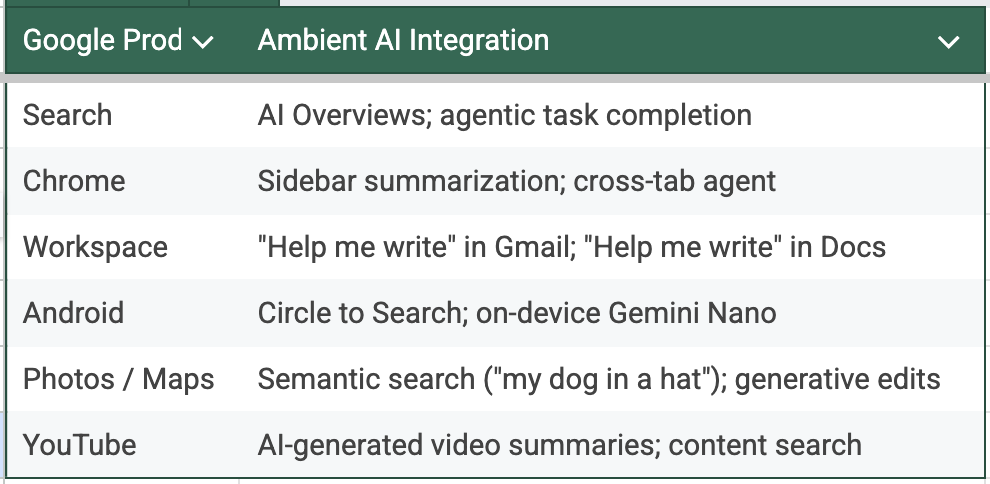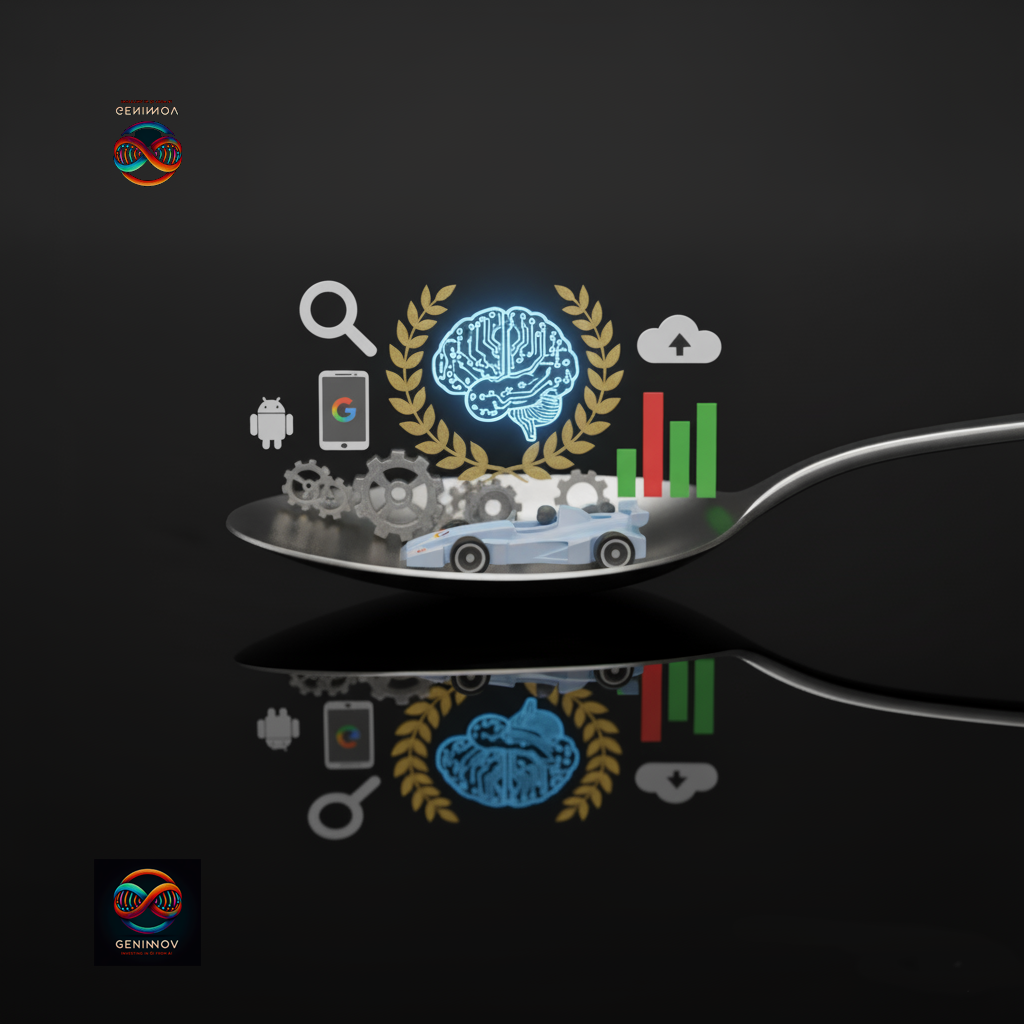As the old saying goes, when a dog bites a man, it’s not news, but when a man bites a dog, it is. Something like that happened in markets recently. When OpenAI announced its new browser and the news sent Google’s share price sliding at least for a day, as it looked like another Google bastion coming under pressure. Just a few months ago, we wrote an open letter to its founder, “Dear Sergey, for AGI, All Google Needs is to Come as One,” highlighting its haphazard approach. Its strategy was unclear. Now, that has changed. Google is emerging as the biggest and most silent winner in the global AI race, more than fulfilling its potential.
The implications are far bigger because of Google's legacy. The market is watching the wrong race. It is looking for a new champion. The reigning one is quietly lapping the field. It is the one to compete against with a tendency to run away, like in Search before, not OpenAI, in the years ahead.
Google’s usage is climbing faster than any other major player. It is likely dominating global AI usage in a way that is not visible to most. Its legacy and dominance in multiple fields give it a powerful foundation. The new story is not about Google being dislodged. The story is about Google becoming the one to beat. Its years of research, its deep data moats, and its control of the digital ecosystem are finally coming together. And, its strategies of stealthily hooking users seem to be working.
The Difficult-to-Fathom Token Explosion
The most staggering figure in the AI race has received little attention. It is the explosion in Google’s token processing. Tokens are the pieces of data that AI models process. This number shows the true scale of Google's AI operations.
While competitors talk in trillions, Google has quietly reached a new level. The growth over the last 18 months is 140-fold or over 30% every month. This has not come from a low base, as Google was near the top even a year and a half ago. We discussed how we were in the Super Moore era, where some things are doubling every few months rather than years since the articles began in mid-2023, but even we were not processing the scale of exponentiality that Google has shown.

For comparison, OpenAI announced in October 2025 that its API processes 6 billion tokens per minute. This is a huge number. It translates to about 260 trillion tokens per month. Google's total is five times larger. OpenAI does not provide the total number of tokens processed, but using some thumb rules, we estimate its token processing is at least a third behind Google's.
This scale is not just about a popular chatbot where stats would show OpenAI with a crushing market share. It is about AI being woven into the fabric of the internet. It is in Google Search, Gmail, Photos, and Android. Every time Gmail suggests a sentence or Search provides an AI overview, tokens are processed. This is ambient AI. It works in the background of daily digital life.
Google's volume comes from a billion-user strategy. It does not need everyone to use a new app. It just makes the apps they already use smarter. The result is a token tsunami.
An Aside on Flawed Metrics
We have a problem with how we measure AI. We are using the wrong tools. This is not new in technology. For years, we have measured data centers by their power consumption. We talk about how many megawatts a facility uses. This is an exceptionally poor measure that has superficially commoditized a highly specialized field.
Power consumption does not indicate a data center's capacity or capabilities. It does not tell you the chip generation. It does not tell you the architecture's efficiency. An efficient data center can do tens of times more with the same power compared to one built with less than cutting-edge technology or with a bad design. But watts are all we have, so we use them.
We see the same problem in AI. One popular metric is "subscribers." This is a useful number for new companies. OpenAI or Anthropic uses it to show growth. They must onboard new users. They need people to sign up. Counting subscribers for Google is like counting people who breathe air. Google does not need to onboard anyone. It has billions of users across its products, where it only needs to make its AI offerings available. And, that’s what it has done. It has embedded AI everywhere.
Still, the token metric is also flawed. The 1.3 quadrillion figure is big, but it is a "window dressing" number. The way models are used changes the token count. A company can use various optimization methods. It can use different routing methods to answer queries. All of these have a material impact on tokens processed for the same input and output. As a result, there can be a huge disconnect between growth in user queries and tokens processed. In the early days of simple models in 2023, a simple query used X tokens. Today, with complex reasoning models, that same query might use 10 or 20 times as many tokens.
Training also uses tokens. A company like Google works on many models at once. It has big teams. It processes far more tokens in training than a small team working on one model.
So, we have no way to anoint the current race leader on the number of “subscribers” or tokens processed. Still, one conclusion is clear: under the Gemini umbrella, we are seeing a rapidly growing type of dominance that the competitors can do little about.
The Browser War Signals Chatbox Inadequacies
This brings us to the agent. Suddenly, every AI company is developing a web browser. OpenAI has Atlas. Perplexity has Comet. Microsoft is pushing Copilot in Edge. This reviewer counted eight browsers on his machine recently. Why?
The reason behind this frenzy is clear. In the all-important, agentic war, an AI agent does not just answer questions. It must take actions. To do this, the AI needs deep access. It needs your data and your permissions. It needs to see your emails, your calendar, your files, and your payment details. It needs to have a complete record of your Internet habits. The browser is the control point for the AI agent.
An exclusive browser is not the only need: as we saw earlier in the year, they also try to create "canvases" or "workspaces." They want your written output to live inside their tool, not in a Google Doc. We saw the personalization efforts with custom GPTs, which never really took off.
This is Google's quiet, unassailable advantage. It does not need to build a new browser to see your data. It does not need a new canvas. Google already owns all these surfaces.
It is a habit. We have seen how hard it is to change user habits. A few years ago, privacy concerns about WhatsApp went viral. There was a global push to switch to Signal or Telegram. Almost none of these efforts succeeded. Users returned to their old habits.
The same is true for browsers. I may use a new browser for its novel AI features. But I quickly return to Chrome. Chrome has my history. It has my extensions. It has my muscle memory. A small new feature is not enough to make me switch.
This is especially true when Google can copy that feature. Google integrates AI into Chrome with only a minor lag. But its true advantage is deeper. Google does not need a chatbot to reach you. It can put AI directly into Maps. It can put it in Docs, Drive, or Gmail. It can be in your calendar or your YouTube feed.
Others start with an extremely weak hand. They need time and money to change habits. Their solutions are partial. They cannot control all the things Google controls.
This is the real story of 2025. It is not just the token volume. It is the integration of Gemini. Google's old approach with Bard was messy. The Gemini brand has unified everything. It is now a seamless layer across the entire Google ecosystem. This is a massive shift from the haphazard strategy of a year ago.

This integration cannot be measured with tokens. Its implications will only be clear later. The full-stack solutions that Google can offer in the Agentic era are possible because of its dominance across fields, so even as competitors raise heads in specific fields, like in a browser or querying, their inability to perform cross-platform activities will be the real driver of who dominates in the years to come.
The Unassailable Stack
Google's advantage is not just its current products. It is the history of research that built them. Unlike other giants, and especially unlike new entrants, Google has been building a complete, vertically integrated stack for over a decade.
Google isn't just building an AI model. It is building a world for its AI to live in. This stack starts with hardware. Google has been developing its own chips, Tensor Processing Units (TPUs), for more than ten years. It does not depend on others for its core infrastructure. This vertical integration —from silicon to software —allows it to optimize its models. It drives down costs. It increases efficiency. This advantage will only grow over time.
The stack includes the models themselves. Google's model development has been ongoing for a decade. This research history, from Google Brain and DeepMind, gives it a huge advantage in multimodality. Famously, we see this in experimental models like "NanoBanana" for image editing or “Veo” in video editing, where it has assertively established new standards despite coming in late. The same could happen next in "Vibe Coding," where Google just announced a feature under Gemini hours ago. Google has been behind, but its ability to catch up is superior because it is able to integrate everything under the “Gemini” banner. Given the initiatives one sees in Google Labs, more social interaction and shopping-related features are coming to Gemini soon.
Finally, the stack includes the platform. Google controls Android, the world's largest smartphone OS. It controls Google Pay, a key to financial transactions. These are not just apps. They are the entry points for the future of agentic AI. They give Google control of the device, the data, and the payment. And, we have not even began talking about Google’s abilities from the knowledge of its users’ email, scheduling, contact, and location histories.
There is more. Google’s AI is not just for search or activities on a computer, in the form of agents, content creation, or coding. DeepMind’s AlphaFold has fundamentally changed protein folding and biology. Waymo, its autonomous driving unit, has driven over 100 million autonomous miles. Google’s models are leaders in robotics and climate technology.
Google's Race to Give Up
There is only one company in the AI-space making fairly interesting announcements almost on a weekly basis, and they are not about JVs or associations that may or may not mean much. Like the vibe-coding announcement of the last few hours, Google’s highly material announcements are rarely noticed, partly because they have become a routine and partly because their implications might be marginal for Google given its size.
The assumption, in general, is that if a start-up-like company announces something in a Google space, it could hurt Google. However, we are not only ignoring how massively Google’s quests are hurting dominant players in image editing or cloud solutions, but also how it is likely to squash the competition, as newcomers draw mind-boggling valuations, whether in vibe coding, shopping, or robotics infrastructure.
This brings us to the final paradox. Alphabet remains one of the lowest-valued stocks among the US tech giants. If its dominance is so clear, why is the stock cheap?
The answer is the business model. Over 90% of Google's revenue still comes from advertising. The biggest threat to this ad business is Google's own AI. Google needs new monetization models to benefit from all discussed above, before it begins to suffer heavily from the demise of the current ways.
The question is what will come first. Google has begun monetizing AI through Google Cloud and new subscriptions. But it also gives many AI solutions away for free, using its massive staying power. For a company of Google's size, these new revenues may not amount to much for a while.
In general, we keep looking at Google’s AI activities in isolation. For example, prediction markets are excited about Google’s upcoming Gemini upgrade. Bettors on platforms like Polymarket expect the new Google model to debut at the top of the capability rankings soon. There are no bets on what may happen next, but one can say with almost 100% surety that Google will not hold that number one spot for long. The race at the frontier is tight. But this misses the point. Google's collective strength is unassailable. Its dominance is not from one model. It is from the entire stack.
It is worth repeating: Google’s monetization struggles do not change the fact that it is racing ahead of competitors in AI usage and agentic development. It is strengthening its hold on old fields like smartphone operating systems and cloud solutions. Unlike each of the other majors except NVIDIA, Google does not need to find its positioning in AI. It simply needs to execute. A year ago, it was failing at this. Now, it is succeeding. Back then, the question was whether Google could survive AI. Today, the question is whether anyone else can survive Google. The race is, and has always been, Google's to give up.



